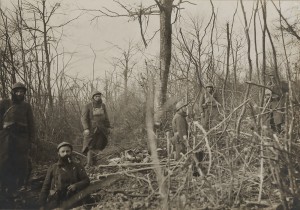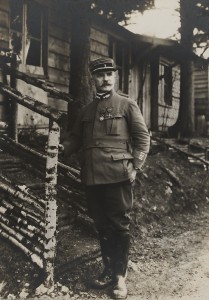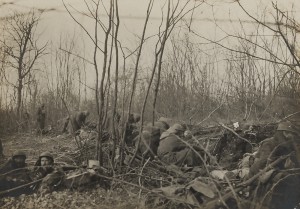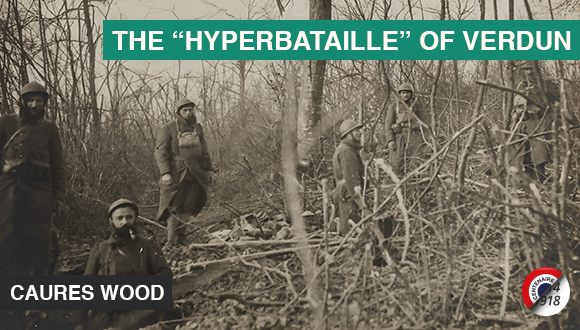 Caures Wood was the most advanced post of the French front lines operating north of Verdun. This sector had been quiet since the beginning of the war. The well organised defence lines of Caures Wood consisted of three distinct lines staggered one behind the other that made this sector one of the best organised within the French front lines.
Caures Wood was the most advanced post of the French front lines operating north of Verdun. This sector had been quiet since the beginning of the war. The well organised defence lines of Caures Wood consisted of three distinct lines staggered one behind the other that made this sector one of the best organised within the French front lines.
 On 21 February, as the German offensive was raging, Caures Wood sector was held by the 59th Battalion of Chasseurs and backed up by the 56th Battalion of Chasseurs on the second line of defence. Over 1,200 men served under the command of Lieutenant-Colonel Driant. Lieutenant-Colonel Emile Driant was elected to the Chamber of Deputies in 1910. As member of the Army Committee of the Chamber of Deputies (Commission de l’Armée de la Chambre), he gave a full account of the poor state of the Verdun defences and warned French General Staff that the Verdun sector – the Région Fortifiée de Verdun (RFV) – was entirely unprepared to resist any attack from the Germans.
On 21 February, as the German offensive was raging, Caures Wood sector was held by the 59th Battalion of Chasseurs and backed up by the 56th Battalion of Chasseurs on the second line of defence. Over 1,200 men served under the command of Lieutenant-Colonel Driant. Lieutenant-Colonel Emile Driant was elected to the Chamber of Deputies in 1910. As member of the Army Committee of the Chamber of Deputies (Commission de l’Armée de la Chambre), he gave a full account of the poor state of the Verdun defences and warned French General Staff that the Verdun sector – the Région Fortifiée de Verdun (RFV) – was entirely unprepared to resist any attack from the Germans.
 On the morning of 21 February, the Germans launched a strong offensive with a heavy artillery barrage on the French front lines. It is believed that some 80,000 shells fell on Caures Wood, an area 3 kilometres (1.8 miles) long and 800 metres (half a mile) wide. Despite the intensity of fire, when the shelling finally stopped at four in the afternoon, the few survivors of Colonel Driant’s 56th and 59th infantry battalions at Caures put up a bitter resistance against the successive German waves of assault, often fighting hand-to-hand amongst the charred remains. During the two days of battle, both battalions had lost over 90 percent of their men. Colonel Driant who had been proved to be in the right was killed as he was forced to order his men to retreat during the afternoon of 22 February. The desperate French resistance enabled to slow down the German advance, and buy precious time to organise the defence of the city of Verdun until the arrival of reinforcements.
On the morning of 21 February, the Germans launched a strong offensive with a heavy artillery barrage on the French front lines. It is believed that some 80,000 shells fell on Caures Wood, an area 3 kilometres (1.8 miles) long and 800 metres (half a mile) wide. Despite the intensity of fire, when the shelling finally stopped at four in the afternoon, the few survivors of Colonel Driant’s 56th and 59th infantry battalions at Caures put up a bitter resistance against the successive German waves of assault, often fighting hand-to-hand amongst the charred remains. During the two days of battle, both battalions had lost over 90 percent of their men. Colonel Driant who had been proved to be in the right was killed as he was forced to order his men to retreat during the afternoon of 22 February. The desperate French resistance enabled to slow down the German advance, and buy precious time to organise the defence of the city of Verdun until the arrival of reinforcements.


Ajouter un commentaire